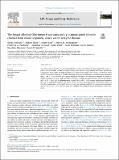Files in this item
The fungal alkaloid Okaramine-B activates an L-glutamate-gated chloride channel from Ixodes scapularis, a tick vector of Lyme disease
Item metadata
| dc.contributor.author | Furutani, Shogo | |
| dc.contributor.author | Ihara, Makoto | |
| dc.contributor.author | Lees, Kristin | |
| dc.contributor.author | Buckingham, Steven D. | |
| dc.contributor.author | Partridge, Frederick A. | |
| dc.contributor.author | David, Jonathan A. | |
| dc.contributor.author | Patel, Rohit | |
| dc.contributor.author | Warchal, Scott | |
| dc.contributor.author | Mellor, Ian R. | |
| dc.contributor.author | Matsuda, Kazuhiko | |
| dc.contributor.author | Sattelle, David B. | |
| dc.date.accessioned | 2018-06-28T13:30:08Z | |
| dc.date.available | 2018-06-28T13:30:08Z | |
| dc.date.issued | 2018-08 | |
| dc.identifier | 253278079 | |
| dc.identifier | ddeb8c3c-cae3-4b5c-8fba-9f965da0a7a1 | |
| dc.identifier | 85048949133 | |
| dc.identifier | 000438125200023 | |
| dc.identifier.citation | Furutani , S , Ihara , M , Lees , K , Buckingham , S D , Partridge , F A , David , J A , Patel , R , Warchal , S , Mellor , I R , Matsuda , K & Sattelle , D B 2018 , ' The fungal alkaloid Okaramine-B activates an L-glutamate-gated chloride channel from Ixodes scapularis , a tick vector of Lyme disease ' , International Journal for Parasitology: Drugs and Drug Resistance , vol. 8 , no. 2 , pp. 350-360 . https://doi.org/10.1016/j.ijpddr.2018.06.001 | en |
| dc.identifier.issn | 2211-3207 | |
| dc.identifier.other | RIS: urn:009802C4974617CBF029FD6389A6F0AA | |
| dc.identifier.uri | https://hdl.handle.net/10023/14714 | |
| dc.description | This work was supported by Merial Ltd., The Japan Society for the Promotion of Sciences (KAKENHI, Grant number: 17H01472) and The UK Medical Research Council. | en |
| dc.description.abstract | A novel L-glutamate-gated anion channel (IscaGluCl1) has been cloned from the black-legged tick, Ixodes scapularis, which transmits multiple pathogens including the agents of Lyme disease and human granulocytic anaplasmosis. When mRNA encoding IscaGluCl1 was expressed in Xenopus laevis oocytes, we detected robust 50–400 nA currents in response to 100 μM L-glutamate. Responses to L-glutamate were concentration-dependent (pEC50 3.64 ± 0.11). Ibotenate was a partial agonist on IscaGluCl1. We detected no response to 100 μM aspartate, quisqualate, kainate, AMPA or NMDA. Ivermectin at 1 μM activated IscaGluCl1, whereas picrotoxinin (pIC50 6.20 ± 0.04) and the phenylpyrazole fipronil (pIC50 6.90 ± 0.04) showed concentration-dependent block of the L-glutamate response. The indole alkaloid okaramine B, isolated from fermentation products of Penicillium simplicissimum (strain AK40) grown on okara pulp, activated IscaGluCl1 in a concentration-dependent manner (pEC50 5.43 ± 0.43) and may serve as a candidate lead compound for the development of new acaricides. | |
| dc.format.extent | 11 | |
| dc.format.extent | 1717891 | |
| dc.language.iso | eng | |
| dc.relation.ispartof | International Journal for Parasitology: Drugs and Drug Resistance | en |
| dc.subject | Glutamate-gated-chloride channel | en |
| dc.subject | Tick Ixodes scapularis | en |
| dc.subject | Ivermectin | en |
| dc.subject | Okaramine B | en |
| dc.subject | Acaricide | en |
| dc.subject | QH301 Biology | en |
| dc.subject | QD Chemistry | en |
| dc.subject | RC Internal medicine | en |
| dc.subject | NDAS | en |
| dc.subject | SDG 3 - Good Health and Well-being | en |
| dc.subject.lcc | QH301 | en |
| dc.subject.lcc | QD | en |
| dc.subject.lcc | RC | en |
| dc.title | The fungal alkaloid Okaramine-B activates an L-glutamate-gated chloride channel from Ixodes scapularis, a tick vector of Lyme disease | en |
| dc.type | Journal article | en |
| dc.contributor.institution | University of St Andrews. School of Biology | en |
| dc.identifier.doi | 10.1016/j.ijpddr.2018.06.001 | |
| dc.description.status | Peer reviewed | en |
This item appears in the following Collection(s)
Items in the St Andrews Research Repository are protected by copyright, with all rights reserved, unless otherwise indicated.

